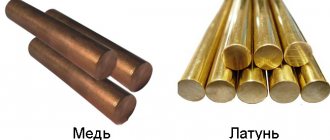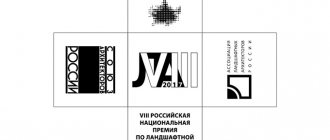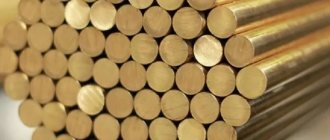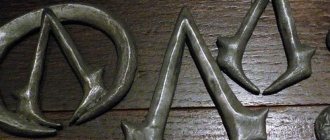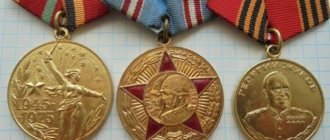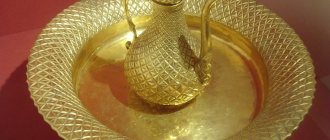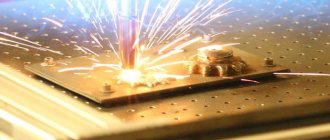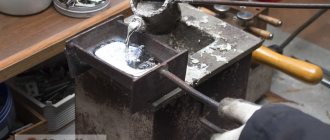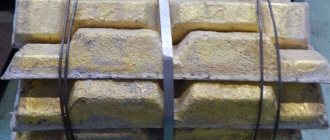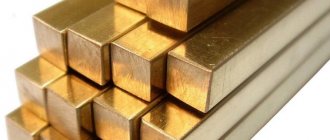What it is?
Tompak is one of the many varieties of brass, which combines zinc and copper in a certain proportion. The comparison of this metal with gold is based only on external similarity, since in terms of chemical composition, characteristics and other features, these two metals are completely different. Although brass has been known to mankind for a long time, they first started talking about tombac only in the eighteenth century - after the discovery made by Christopher Pinchbecker. At that time, a similar alloy was actively used in England. And only a few decades later its popularity spread to other countries.
On the similarity of tombac to a jewelry mineral, many dishonest people were able to make good money by passing off coins and jewelry made of brass alloy as real ones made of gold.
The metal in question can be called similore, princetal, chrysorine, chrysochalk, ororeid. When you hear these names, don’t be surprised - they’re all the same metal.
Tombak has many advantages:
- good resistance to corrosion damage;
- excellent wear resistance;
- good weldability with other metals;
- plasticity is sufficient for the use of deformation and engraving methods;
- possibility of enameling and gilding;
- immunity to magnets.
One type of metal, called polutompak . Its difference from tombak lies in the percentage of zinc, which can range from 10–20%. This feature explains the change in the basic properties of the metal:
- rich yellow color;
- decreased plasticity;
- increased refractoriness.
Such characteristics make it possible to use semi-tombak for the production of some technical parts. This type of metal is less common compared to tombac. This is due to the presence of a large number of deficiencies due to the high zinc content in it.
Using tombak in different areas
Tompak is a type of brass, an alloy of copper and containing zinc, but not more than 10%. To give tombac the properties of ductility, ease of processing and strength, it can be modified by adding small amounts of lead, iron, phosphorus, arsenic and other so-called additives.
A little history
This alloy has been known since the times of ancient South American pre-Columbian civilizations; brass jewelry, dishes, and tools were found during archaeological excavations.
Instead of zinc, the production secret of which was lost in Europe in the 10th-11th centuries and rediscovered only a few centuries ago, the alloy was made at that time using rich zinc-containing ore - galmey (a mixture of zinc spar ZnCO3 and zinc silicate).
Steel radiators
Steel radiators are divided into two types according to their design: tubular and panel.
Tubular
They are a series of steel tubes, round, oval or rectangular in cross-section, united by collectors, or in the form of sections connected by welding, similar to those used for cast iron batteries. In this case, the tubes can be positioned vertically, horizontally, or even at an angle to the vertical.
General design characteristics:
- the height of the device can vary between 15-300 cm;
- width from 20 cm to 200 cm or more;
- depth ranges from 5 to 30 cm;
- The thickness of the tube walls is 1.2–2 mm.
Connection to the heating system pipelines is carried out using fittings; there are two connection options - side and bottom.
Panel steel
By design, a panel radiator is assembled from two or three flat panels, each of which consists of a pair of stamped ribbed sheets connected to each other by welding along the contour. When connecting sheets inside the panel, vertical channels are formed for coolant circulation. The panels are connected to each other by pipes through which the coolant flows, and the space between the panels is additionally equipped with plate convectors for greater heat transfer.
Panel radiators are classified by type depending on their design and size in a two-digit number:
- 10 - from one panel without a convector and cladding with an installation length ranging from 40.5 - 300.5 cm, a height of 30.5 - 90.5 cm, an installation width - 63 mm;
- 11 – with one panel, convector and cladding, length 40.5 – 300.5 cm, height 30.5 – 90.5 cm, width – 63 mm;
- 12 – with two panels, a convector and cladding, length 40.5 – 300.5 cm, height 30.5 – 90.5 cm, width – 66 mm;
- 20 – with two panels without a convector, equipped with an air-permeable grille, length 40.5 – 300.5 cm, height 30.5 – 90.5 cm, width – 102 mm;
- 21 – with two panels, a convector and a casing, length 40.5 – 300.5 cm, height 30.5 – 90.5 cm, width – 102 mm;
- 30 – with three panels without convectors and casing, length 40.5 – 300.5 cm, height 30.5 – 90.5 cm, width – 157 mm;
- 33 - with three panels and three convectors, equipped with a casing, length 40.5 - 300.5 cm, height 30.5 - 90.5 cm, width - 157 mm.
The heat transfer of the devices directly depends on the number of panels and the presence of convectors - the more panels and convectors, the more powerful the convection heat flow of air will be, and accordingly, the faster the room will warm up.
The connection can be made from below or from the side.
Bimetallic
One of the types of modern heating devices is aluminum radiators, which have good heat transfer performance, but have one significant drawback. Aluminum is very sensitive to the acid-base balance of the coolant, which must be within strictly defined limits - pH = 7-8. When using a coolant with a pH value outside these limits, they quickly corrode and fail.
In order to eliminate this drawback, bimetallic heating devices were developed.
The design of a bimetallic radiator is a frame consisting of two horizontally located collectors and vertical heat-conducting channels (all made of steel pipes of a certain diameter), onto which a ribbed-plate casing made of aluminum is attached on top. The coolant circulates through the pipes of the collectors and heat-conducting channels, heating the aluminum casing, which in turn transfers heat to the premises.
Design characteristics:
- height, or the distance between the axes of two horizontal collectors in the range of 20 - 80 cm. The total height of the devices exceeds the interaxial distance by 6-8 cm;
- depth within 75-100 mm;
- The width of one casing rib is 80 mm.
Bimetallic devices can be of two types: sectional and cast. The sectional one is assembled from separate sections, while the sections of manifold pipes of each section have multi-directional threads and are connected using nipples with sealing gaskets. Sectional radiators have an advantage over cast ones due to the ability to expand any number of sections, which is impossible to do with cast devices. But on the other hand, this type of device can withstand much less pressure than cast ones.
In cast instruments, the monolithic body is cast in special molds. Compared to sectional cast radiators, they can withstand significantly greater coolant pressure, that is, they are not subject to the risk of damage due to water hammer, which is possible in the central heating systems of apartment buildings.
In addition, models are produced with an internal frame made of copper pipes, which are much more resistant to corrosion than steel ones, but such devices are much more expensive.
Effect of impurities on properties
Impurities are not the main alloying elements of simple brasses, but they affect the properties of the alloys. It is almost impossible to obtain an alloy without impurity atoms, since foreign elements are contained in the raw materials for the production of copper and zinc. Ultrapure metals have a high cost and their use is highly specialized and not justified for mass production. The amount of impurities is controlled by standards, which guarantees the mechanical and technological properties of grade copper alloys.
Low-melting impurities, which have limited dissolution in copper-zinc alloys, negatively affect the properties of brass. Low-melting inclusions in the brass composition are released along the grain boundaries and worsen the plastic properties during hot deformation. Single-phase α-brasses are most sensitive to such impurities.
Impurities that do not form independent phases do not negatively affect the mechanical and technological properties of brass.
- Aluminum is completely in solid solution and, as an impurity, does not deteriorate the properties of brass. Small additions of aluminum during melting form a protective film of aluminum oxide on the surface of the melt. This prevents the evaporation and loss of zinc.
- Nickel and manganese in low concentrations enter the solid solution and have little effect on the physical, mechanical and technological properties of brass. Nickel raises the recrystallization temperature of brasses.
- Iron at room temperature has low solubility in the copper-zinc solid solution and forms an independent γFe phase in brasses. This ferromagnetic phase significantly changes the magnetic properties of brasses. The iron concentration in antimagnetic brass does not exceed 0.03%. Iron improves the strength and technological qualities of alloys, since it makes recrystallization difficult and refines the grain.
- Silicon is an impurity that enters a solid solution. Silicon improves soldering and welding of brass and increases resistance to corrosion cracking.
- Bismuth requires special control; it does not dissolve in brass alloys in the solid state and creates a low-melting eutectic at the grain boundaries, which consists of pure bismuth. Bismuth provokes the hot brittleness of brasses, having a stronger effect on single-phase ones. Its concentration in brasses is limited to 0.002–0.003%
- Lead is slightly soluble in copper-zinc alloys in the solid state and, upon solidification, is released in elemental form at the grain boundaries in the form of small spherical particles. Lead impurities impair the ductility of α-brasses at elevated temperatures. Lead provokes hot brittleness, especially in single-phase brasses, so the lead content in double α-alloys does not exceed 0.03%. Additions of lead to brass improve machinability.
- Antimony is a harmful impurity in copper-zinc alloys. It impairs technological ductility during hot and cold forming. Antimony concentrations of up to 0.1% in two-phase brasses prevent dezincification.
- Arsenic dissolves in solid copper up to 5% by weight at a temperature of 25°C, but in a copper-zinc solid solution its solubility is no more than 0.1%. The brittle intermediate phase As2Zn is formed at an arsenic concentration of more than 0.5%. This phase is released in the form of interlayers at the grain boundaries, which leads to brittleness of brass. Arsenic in small quantities of 0.025-0.06% with microadditives protects brass from corrosion cracking and dezincification in sea water.
- Phosphorus is slightly soluble in copper-zinc alloys during solidification. In a solid solution, phosphorus forms an intermediate phase, which increases the hardness and greatly reduces the plastic properties of brass. Small amounts of phosphorus increase the mechanical properties of brasses and reduce the grain diameter of castings. The rate of grain growth in deformed brasses is increased by phosphorus during recrystallization annealing. Copper-zinc alloys do not require deoxidation with phosphorus, since zinc is a stronger deoxidizer than phosphorus. In industrial grades of brass, the phosphorus content does not exceed 0.005-0.01%
Chemical composition and main characteristics
The alloy of zinc and copper, known to many, has been used for a long period. An example is that it was used in the manufacture of the first tools and some jewelry, as well as household utensils. Tompak was also obtained several centuries ago and was actively used by humans. In common parlance it also has names: similor, oreid, chrysochalk, chryzoin, princetal.
A certain chemical composition makes the alloy widespread. An example is the active use of tombak in the manufacture of various counterfeits and decorative elements, since it resembles gold.
As previously noted, the alloy in question is a combination of zinc and copper, and therefore belongs to the brass group.
At the same time, the composition of the alloy is significantly different, copper from 88 to 97%, zinc no more than 10%.
Do not forget that strength and other properties largely depend on the concentration of zinc. This element also largely determines the color of the material. Due to a significant increase in zinc in the composition, the color changes from red to light yellow, which is characteristic of gold. In addition, the following qualities change:
- Antifriction properties are significantly increased.
- Chemical and technological characteristics are improved.
- The cost is significantly reduced compared to the price of pure copper.
The tombac used is characterized by quite a large number of advantages, which include the following:
- The material is characterized by increased resistance to corrosion.
- The wear resistance of the surface layer is significantly increased.
- The alloy has increased weldability.
- High ductility largely determines the possibility of application when using products on which engraving is applied.
- It is possible to expose the surface to enamel and gold powder.
- The absence of magnetic properties can also be called an important material property that must be taken into account.
The conducted research allows us to determine the basic properties of tombak. They are as follows:
- Hardness reaches 145 MPa.
- The melting point is 1040 degrees Celsius.
- Relatively low coefficient of friction.
- The tensile strength of the created product is about 520 MPa.
- The relative elongation is 3%.
In general, we can say that tombak has exceptional performance characteristics. They determine the scope of application.
Reanimation of the surface from oxide
Due to their wear resistance, brass and all its types are called “eternal metal”. But this does not mean that products made from these alloys do not need to be looked after. They, like silver, darken, especially due to contact with water. It’s easy to fix the situation; let’s look at several ways to clean brass.
For the simplest case, you will need acetone, soap, water and a cotton pad. Prepare a weak soap solution and soak the cotton wool in acetone. Wipe the product thoroughly with a disc and then wash it in the solution. All that remains is to dry it and enjoy the magnificent view. The second method is also available to any housewife. You will need a metal container with a minimum capacity of 3 liters, water, 250 ml of simple vinegar and 25 g of salt. Mix all the ingredients, place the brass product in the solution and place the pan or bowl on the fire. Bring to a boil and add clean water if necessary. We continue until the brass item is clean.
The following method can be dangerous to the skin and eyes, so it requires caution. To clean tombac using this method, mix 10 liters of water and 200 g of oxalic acid in a plastic container. This method is used for processing large products. Be sure to follow safety precautions. Wear rubber gloves and a respirator. Carefully place the product in a container with the solution and leave it there for several hours. Then very carefully remove it and rub it with a dry cloth.
This is interesting: Ejector - what is it? The principle of operation of ejector pumps and their design
You can also clean tarnish with lemon. Cut the fruit and immerse it in table salt, and then rub the surface to be treated. If you also need to polish, then a simple toothpaste will come in handy. Rub it in with a cotton cloth, and then rinse the element in clean running water.
Before cleaning, make sure that the product is actually made of brass and not covered with it. To do this, just bring a magnet. Tompak will not react at all. If the item is just coated with a thin layer of alloy, do not use abrasive substances, as this can easily damage the surface layer.
First way
Prepare a solution consisting of 3 liters of water, a small tablespoon of salt (25 g) and a glass of ordinary vinegar. The product should be placed in this solution and boiled until the surface is completely clean. As necessary, add water to the original volume. After cleaning, the item is washed with running water and dried.
Second way
The item that needs to be cleaned is carefully placed for several hours in a solution consisting of 10 liters of water and 200 ml of oxalic acid. To make it, you must use plastic containers. Use this volume of solution to clean large products. When cleaning small items and the need to use less solution, you can proportionally reduce the volume of components. This method is potentially dangerous to the skin and eyes, therefore, if used, it is necessary to use rubber gloves and a respirator as personal protective measures. After cleaning, the product must be thoroughly rinsed under running water and rubbed with a dry cloth.
Products with enamel, glass inserts, other metals, paintings and other artistic elements are not recommended to be cleaned using these methods.
Third
A solution containing water and soap is required. You also need acetone. A cotton swab or disk is moistened in acetone and the product is thoroughly wiped with it. After such treatment, it is washed with soapy water until the original shine of the surface is completely restored and be sure to wipe dry.
Fourth method
The simplest one is to wipe the surface of the product to be cleaned with half a lemon or lime, which is first dipped in table salt. After such cleaning, the surface can be polished with regular toothpaste and a cotton cloth as a gentle abrasive polishing compound. Then you need to rinse the item in running water and wipe dry.
Fifth method
You need to buy a cleaning agent for non-ferrous metals in retail chains. Most often it is sold in the form of tubes with cream or paste, and apply it strictly according to the instructions.
Sixth method
Polish the product using GOI paste. This product is called the paste of the State Optical Institute and was developed about 80 years ago. To clean and polish the product, apply the paste to a soft cloth. A few drops of spindle oil are applied to better dissolve the paste, and then the product is polished with slow movements. After polishing, the item is washed to degrease and wiped dry.
Definition
What are bimetals? One of the layers of such materials is most often inexpensive steel. The second layer is made of expensive non-ferrous or even noble metals. Composites of this type are usually used when it is necessary to impart special properties to the product. Also, the use of such materials in various fields helps to save on aluminum, copper, bronze, silver, etc.
Thus, what a bimetal is is clear. This is a composite, most often consisting of two layers. Such materials differ from ordinary ones in special properties. The layer of cheap steel in bimetals is always called the base layer. A layer of expensive material is cladding.
The page provides examples of photos of different types of bimetals and products made from them. Materials of this type are actually used very widely in the national economy.
This is interesting: Brass - composition, grades, characteristics of the alloy
Alloys in orthopedic dentistry
Metal occupies a central place among materials in dentistry. Most fixed dentures and removable denture frames are cast (or stamped) from dental alloys. Alloys in dentistry are used as auxiliary materials for soldering and stamping. Dental instruments are made from them.
Article outline:
- Classification of metals and alloys in dentistry
- Structural metal alloys in orthopedic dentistry
- Noble metal alloys in dentistry
- Base alloys in orthopedic dentistry
- Auxiliary metal alloys in dentistry
Composition and properties
Tompak is an alloy containing zinc and copper, which allows it to be called a type of brass. The composition of this compound can vary greatly:
- the percentage of copper can vary from 88 to 97%;
- the percentage of zinc should be no more than 10%.
Many properties, including strength and color, are determined by the concentration of zinc . As the content of the latter increases, the color changes from red to a delicate shade of yellow, which is as close as possible to gold. Also in this case, a number of characteristics of the metal change:
- increasing anti-friction properties;
- improvement of chemical and technological features;
- lower cost of the alloy (compared to copper).
Tompak has a number of distinctive features:
- hardness is about 146 MPa;
- the melting point is at 10450 degrees;
- the friction coefficient in the absence of lubrication is 0.44, and with the addition of lubricants this figure decreases to 0.074;
- tensile strength is in the range of 445–525 MPa;
- relative elongation after rupture – 3%;
- density – 8780 kg/m3.
The described parameters of tombak can be improved by adding various components in not very large quantities. In this way, it is possible to obtain alloys with an optimal combination of main characteristics. This metal is produced in the form of sheets or bars. Markings are applied to the metal, by which its chemical composition can be determined. For example, the presence of the letter "L" indicates that it is brass. From the numbers you can determine the amount of copper.
In addition to copper and zinc, it also includes other impurities; their presence and quantity can be found in specialized tables.
Types of copper-nickel alloys
A copper alloy alloyed with nickel forms a large number of solid solutions, which are divided into several groups:
- structural;
- electrical;
- jewelry.
The main characteristics of structural copper-nickel alloys: high hardness, abrasion resistance, corrosion resistance. Manganese, chromium, aluminum, zinc and other components are used together with nickel.
In electrical alloys, the manganese content may exceed nickel. The alloys have stable resistance and high conductivity.
Decorative compounds include copper and nickel compounds that lend themselves well to various types of processing: cutting, deformation. They have high fluidity.
Constantan
The alloy is marked - MNMts 40-1.5. This designation indicates that it contains about 40% nickel. Constantan belongs to electrical materials. It has high ohmic resistance and low linear expansion when heated.
Plastic material can be easily processed by rolling. Wire and sheets for thermoelectrodes and converters are made from constantan.
Kopel
A copper-nickel alloy with high thermal stability, marked MNMts 43-0.5. An additional alloying component is manganese. Available in the form of wire of various diameters. Used for the manufacture of compensation wires and low-temperature converters. Resistant to acidic environments, works in inert gases.
The main property is high stability of resistance when changing temperatures. Refers to heat-resistant materials. Stably retains its characteristics at temperatures up to 600⁰.
Wire
Nickel silver
Jewelry copper alloy with a nickel content of 15% and zinc within 20%. Nickel gives the alloy a white color with a greenish or blue tint.
German chemists invented the alloy as a cheap substitute for white gold, no different in appearance. Nickel silver turned out to be harder, resistant to moisture and steam. Does not darken and does not lose its decorative properties. In Europe it was used to make awards and jewelry. Currently, medals, orders, guitar frets and surgical instruments are made from it.
Kunial
The alloy is available in 2 versions and has the letters A and B at the end of the marking. Both types of alloy are corrosion resistant. At elevated temperatures it is prone to cracking.
Kunial-A is additionally alloyed with aluminum, cobalt and iron. Produced in the form of rods.
Kuniali-B - only nickel is dissolved in copper, the content of other substances in total is no more than 1%. The material is used to make strips for springs and springs.
Manganin
In addition to copper and nickel, this alloy contains 13% manganese. It has a beautiful golden-red color. Manganin may contain iron. It belongs to the initially aged alloys - it acquires its mechanical properties after heat treatment. Possesses electrical stability under temperature changes.
Manganin is used in high-precision electrical measuring instruments to create standards.
There is another alloy composition in which copper is replaced by silver. The technical characteristics are practically the same. White Manganin is much more expensive.
Monel
In addition to copper and nickel, manganese and iron are added to the alloy. Monel is named after the head of the American chemical laboratory where the alloy was developed. The material is corrosion resistant, ductile and durable. It is highly resistant to acids and alkalis. Marked - NMZHMts28-2.5-1.5.
Monel is used in the manufacture of instruments and equipment for the chemical and oil industries. Used in apparatus manufacturing, medicine and the shipbuilding industry for the manufacture of anti-corrosion parts.
The alloy is highly plastic, easily processed in cold and hot conditions. Mechanical processing is only possible at low speeds.
Cupronickel
White carbide contains copper in the range of 70–90%. Refers to jewelry compositions. In addition to nickel, it has alloying substances:
- 0.8% iron;
- 1% manganese.
It has high corrosion resistance in sea soda and gas environments. The melting point is in the range of 1150–1230⁰, does not depend on the ratio of the components.
The most common brands of cupronickel are MNZhMts30-1-1 and MN16. It receives its technical characteristics after annealing. Belongs to the group of initially aged alloys.
Cupronickel is used to make spoons, forks, tableware, and various decorations. It lends itself well to processing, carving, and embossing. Surgical instruments, coins, and medals are made from it.
Practical nuances of operation
In addition to the characteristics that can be expressed in numbers, there are also nuances associated with the practical use of this or that type of radiator. Here it is worth considering the main pros and cons of bimetallic batteries compared to aluminum and cast iron. Let's start with the positive features:
- Bimetallic radiators have high heat transfer.
- Having steel pipes, they can easily withstand a decrease in the quality of the coolant.
- These solutions boast maximum operating pressure.
- Bimetallic batteries have an extremely long service life, and the manufacturer’s warranty for them is the longest.
- These radiators can operate with coolant volumes that are several times smaller than those of competitors. This increases the efficiency of the heating system.
- Due to their small size, bimetallic batteries generally benefit from aesthetic indicators, and their dimensions are acceptable.
- This type of radiator is least susceptible to corrosion (including when draining the coolant).
- Bimetallic batteries do not suffer from leaks in inter-threaded connections.
- When using them, there is no need to remove air through a special valve.
- Such radiators are not sensitive to oxygen accidentally entering the system.
Do not forget that such radiators are not a universal solution - they have their disadvantages:
- The price of bimetallic batteries is usually higher than that of aluminum and cast iron (although not always).
- This class of solutions has a lower flow area, which slightly reduces heat transfer.
- Such batteries have higher hydraulic resistance, which requires more power to pump the same volume of coolant through the system.
Where is Tompak used?
Tombak is used for cladding steel, i.e. coating the surface of steel products with a thin layer of an alloy, which is used in the manufacture of charges and bullets for firearms and producing a steel-brass bimetal. The use of such bimetallic sheets saves stainless steel and non-ferrous metals, protecting the steel core from corrosion and destruction and giving the surface the desired properties. This technology can dramatically reduce the cost of the product. Bimetal is used for various elements of chemical equipment, where other coatings cannot cope with corrosion. Bimetallic wire is used for communication lines. Tombak is used for the manufacture of high-precision measuring and other equipment.
Due to its good resonator properties, the bells of brass wind musical instruments are made from the alloy. It is used to make:
- artistic products (paintings made using metal chasing technique);
- radiator tubes and drawn pipes with a diameter of up to 30 mm;
- insignia;
- accessories;
- cigarette cases and cigarette holders;
- some types of medals and coins.
For example, Russian coins in denominations of 10 and 50 kopecks. School Gold medals are made from tombac and then gilded. The bronze medals of the 1980 Summer Olympics in Moscow were made of tombac. In 1942-1943, Canada issued tombac coins in denominations of 5 cents.
Due to its beautiful color and ease of processing, tombak is widely used by jewelers in the manufacture of costume jewelry. The alloy is used to make dishes, figurines, candlesticks, and in interior decoration and furniture. In Eastern countries, elegant thin-walled waterware, jugs, bowls, and trays are made from tombac, which is decorated with unique patterns, thereby creating works of art. The dishes are protected from the destructive effects of water on the alloy by tinning with tin, which allows the artistic beauty of the products to be preserved for a long time.
Production methods
Methods for obtaining tombak have expanded significantly since its discovery, but the essence of each of them comes down to a single scheme.
- The composition is heated in an electric oven to 1300–1400 degrees. With such heating, silicate is released, floating to the surface of the alloy, which makes it possible to remove it from there without unnecessary difficulties.
- The resulting metal is poured into a container and purged with oxygen. This stage requires the use of special equipment. This treatment provokes the release of thermal energy in large quantities and triggers a chemical reaction.
- At this stage, copper is formed, which contains many impurities, which reduces its properties.
- The composition is subjected to electrical cleaning using acidified copper sulfate.
- Zinc is added to molten copper to produce a strong alloy with high corrosion resistance.
The process of obtaining tombak is complex, labor-intensive and energy-consuming. This explains the high cost of the metal, which is still much lower than the price of gold.
Manufacturing
In the brass production process, special cards are used indicating the melting technology; it is developed in industrial bureaus. Often the raw materials for the alloy are copper blanks, as well as zinc scrap. The melting operation of this material is a complex process for which furnaces of various modifications are used. Induction units operating in a low-frequency network with a magnetic core are more often used.
When melting, substances may evaporate from the composition. Since zinc is considered a metal harmful to health, it is recommended to install high-power ventilation in production areas. During the entire cycle, temperature indicators are monitored, which prevents the alloy from igniting.
It is recommended to first clean the furnace cavities from previous casting products. Next, the copper blanks are heated to a bright red hue, then zinc scrap is added. This sequence prevents the formation of oxidative reactions. Casting-type brass is poured into round, flat molds for ease of subsequent processing.
To improve the quality of the alloy, use:
- tin and manganese, which increases strength and resistance to destruction in an aggressive environment;
- lead, as a result, the brass workpiece can be processed with cutters on a machine;
- high resistance to acidic and alkaline environments is achieved by adding nickel;
- aluminum protects the alloy from zinc evaporation during casting;
- silicon improves welding properties with metals, but reduces strength.
Tompak - Steel - Tompak
TU 1881-004-55680513-2004 Multilayer tapes grade L90StL90. Specifications
Description
Multilayer bimetallic tape of the L90StL90 brand is made of low-carbon steel, clad on both sides with L90 tombac.
Compound
- The base is low-carbon high-quality steel grade 08Yu with a chemical composition in accordance with GOST 9045.
- The coating is L90 brass with a chemical composition in accordance with GOST 15527.
The thickness of the cladding layer h1 and h2 is the same for both sides and ranges from 4 to 6% of the thickness of the finished strip. At the Customer's request, the thickness of the cladding layer can be up to 10% per side.
Classification and assortment
According to the condition of the material:
- soft – M
- trained - D
- semi-solid – P
- hard - T
By type of edges:
- with cut edge – O
- without cut edge – N
Specifications
Variety
Thickness H , mm
Thickness tolerance, mm
Width B , mm
Width tolerance, mm
Length, mm
Internal diameter of the roll Øinternal, mm
Roll weight, kg
For tapes with unedged edges, the width tolerance is (±1.0) mm. It is possible to manufacture other standard sizes to an agreed tolerance.
Mechanical properties
Tape Condition
Tensile strength σ B , MPa
Relative extension
δ, %
Application
For the production of electrical and automotive products, cable armoring.
OST 3-6649-91 Tapes and strips made of Bimetal 3. Technical conditions
Description
Bimetallic tapes and strips Bimetal 3 are made of low-carbon steel, clad on both sides with L90 tombak.
Compound
- The base is low-carbon high-quality steel grade 08Yu with a chemical composition in accordance with GOST 9045, steel grade 11YUA with a chemical composition in accordance with GOST 803 or steel 11kp with a chemical composition in accordance with GOST 1050.
- The coating is L90 brass with a chemical composition in accordance with GOST 15527.
The thickness of the cladding layer h1 and h2 is the same for both sides and ranges from 4 to 6% of the thickness of the finished strip. At the Customer's request, the thickness of the cladding layer can be up to 10% per side.
Copper-zinc alloys (brass) for casting (according to GOST 17711-93)
Chemical composition of foundry brasses, %
| Name and grade of alloy | Main components* | Total impurities | ||||||
| Cu | Al | Fe | Mn | Si | Sn | Pb | ||
| Lead brass: | ||||||||
| LTs40S | 57,0-61,0 | — | — | — | — | — | 0,8-2,0 | 2,0 |
| LTs40Sd | 58,0-61,0 | — | — | — | — | — | 0,8-2,0 | 1,5 |
| Manganese brass | ||||||||
| LTs40Mts1.5 | 57,0-60,0 | — | — | 1,0-2,0 | — | — | — | 2,0 |
| Manganese-iron brass | ||||||||
| LTs40MtsZZH | 53,0-58,0 | — | 0,5-1,5 | 3,0-4,0 | — | — | — | 1,7 |
| Manganese-aluminum brass | ||||||||
| LTs40MtsZA | 55,0-58,5 | 0,5-1,5 | — | 2,5-3,5 | — | — | — | 1,5 |
| Manganese-lead brass | ||||||||
| LTs38Mts2S2 | 57,0-60,0 | — | — | 1,5-2,5 | — | — | 1,5-2,5 | 2,2 |
| Manganese-lead-silicon brass | ||||||||
| LTs37Mts2S2K | 57-60 | — | — | 1,5-2,5 | 0,5-1,3 | — | 1,5-3,0 | 1,7 |
| Aluminum brass | ||||||||
| LCZ0AZ | 66,0-68,0 | 2,0-3,0 | — | — | — | — | — | 2,6 |
| Tin-lead brass | ||||||||
| LTs25S2 | 70,0-75,0 | — | — | — | — | 0,5-1,5 | 1,0-3,0 | 1,5 |
| Aluminum-ferromanganese brass | ||||||||
| LTs2ZA6ZhZMts2 | 64,0-68,0 | 4,0-7,0 | 2,0-4,0 | 1,5-3,0 | — | — | — | 1,8 |
| Silicon brass | ||||||||
| LTs16K4 | 78,0-81,0 | — | — | — | 3,0-4,5 | — | — | 2,5 |
| Silicon-lead brass | ||||||||
| LTs14KZSZ | 77-81 | — | — | — | 2,5-4,5 | — | 2,0-4,0 | 2,3 |
*The rest is zinc.
Mechanical properties of casting brasses (according to GOST 17711-93)
| Brass grade | Casting method | Temporary resistance phenomenon of rupture σв , N/mm2 | Take it telial elongation δ5 , % | Hardness HB | Approximate purpose |
| no less | |||||
| LTs40S | P | 215 | 12 | 70 | For casting fittings, bushings and cages for ball and roller bearings |
| K, C | 215 | 20 | 80 | ||
| LTs40Sd | D | 196 | 6 | 70 | For injection molding of fittings (bushings, tees, adapters), bearing cages operating in air or fresh water |
| TO | 264 | 18 | 100 | ||
| LTs40Mts1.5 | P | 372 | 20 | 100 | For the manufacture of simple configuration parts operating under shock loads, as well as parts of friction units operating under quiet load conditions at temperatures not exceeding 60 °C |
| K, C | 392 | 20 | 110 | ||
| LTs40MtsZZH | P | 441 | 18 | 90 | For the manufacture of parts with simple configurations from for critical purposes and fittings for marine shipbuilding, operating at temperatures up to 300 °C; massive parts, propellers and their blades for the tropics |
| TO | 490 | 10 | 100 | ||
| D | 392 | ||||
| LTs40MtsZA | K, C | 441 | 15 | 115 | For the manufacture of parts of simple configurations |
| LTs38Mts2S2 | P | 245 | 15 | 80 | For the manufacture of structural parts and equipment for ships; anti-friction parts of simple configuration (bushings, liners, sliders, car bearing fittings) |
| TO | 343 | 10 | 85 | ||
| LTs37Mts2S2K | TO | 343 | 2 | 110 | Anti-friction parts, fittings |
| LTsZ0A3 | P | 294 | 12 | 80 | For the manufacture of corrosion-resistant parts, use employed in shipbuilding and mechanical engineering |
| TO | 392 | 15 | 90 | ||
| LTs25S2 | P | 146 | 8 | 60 | For the manufacture of fittings for hydraulic systems of automobiles |
| LTs23A6ZhZMts2 | P | 686 | 7 | 160 | For the manufacture of critical parts operating under high specific and alternating loads, during bending, as well as anti-friction parts (pressure screws, nuts of pressure screws of rolling mills, worm wheel rims, bushings and other parts) |
| K, P | 705 | 7 | 165 | ||
| LTs16K4 | P | 294 | 15 | 100 | For the manufacture of parts of devices and fittings with complex configurations, operating at temperatures up to 250 °C and subjected to hydroelectric testing; details, working in a seawater environment, provided that tread protection (gears, parts of friction units, etc.) |
| TO | 343 | 15 | 110 | ||
| LTs14KZSZ | TO | 294 | 15 | 100 | For the manufacture of bearings, bushings |
| P | 245 | 7 | 90 |
Note.
In the column “Casting method” the letters mean:
- P – sand casting;
- K – chill casting;
- D – injection molding;
- C – centrifugal casting.
What do steel and bimetallic radiators have in common, what are their differences?
When solving issues regarding the installation of indoor heating systems, their owners always have to solve the problem: which heating device is better? To get an answer to the question, you need to know the parameters for choosing these devices.
The comparison table below shows the similarities and main differences between steel and bimetallic heating radiators.
Table . Comparative characteristics of steel and bimetallic radiators.
| Steel panel radiators | Tubular steel radiators | Bimetallic radiators | |
| Design | welded | welded | sectional, monoblock |
| Connection | any | any | lateral |
| Thermal inertia | low | low | low |
| Coolant volume | small | average | small |
| Installation of thermostats | recommended | recommended | recommended |
| Corrosion resistance | average | high | high |
| Coolant | water, antifreeze | water | water, antifreeze |
| Permissible coolant temperature (degrees) | 110 – 120 | 110 – 120 | 110 – 130 |
| Working pressure (bar) | up to 1 | up to 1 | up to 2.5 |
| Coolant pH restrictions | 6,5 – 9 | 6,5 – 9 | 6,5 – 9 |
| Corrosive effects of stray currents | Yes | Yes | Yes |
| Operating/pressure/destruction pressure (bar) | 6-12/9-18/27 | 6-12/9-18/27 | 35/57/75 |
| Use in tall buildings | Not recommended | recommended | recommended |
| Range of models | wide | wide | wide |
| Peculiarities | recommended for rooms with increased requirements for cleanliness | ||
| Warranty period (years) | 1 | 1 | 3 – 10 |
It should be noted that it is quite difficult for an untrained person to get a comprehensive answer to the question of which batteries are better. Only a specialist can fully answer this question after familiarizing himself with the heating system of a particular house.
What is a semi-tompak?
Semi-tompak should be included in a separate category. The differences lie in the concentration of zinc, which increases to 10-20%. Due to this, the basic properties of tombak change. The key features are the following:
- The product takes on a more yellow tint.
- The degree of ductility decreases and refractoriness increases.
- The material is often used to make technical parts.
This alloy is found much less frequently in comparison with tombac. This is due to the fact that an increase in the amount of zinc causes a large number of deficiencies to appear.
Brass classification
By composition, brass is of the following types:
- Two-component - zinc plays the role of the key alloying element. Such alloys are marked with the letter “L” and indicating the percentage of inclusion of copper raw materials, for example, L63, L68, L80.
- Multicomponent - in addition to the main components, lead Pb, nickel Ni, aluminum Al, tin Sn, manganese Mn may be included, due to which the material acquires additional qualities and colors. The marking of such alloys contains the letters of their components and their percentage in the total volume. For example, LS63-3 means that 63% is copper, 3% is lead and 34% is zinc.
Depending on the production and processing technology, brass alloys are divided into:
- deformable (such as wire, rod, sheet, pipe, tape);
- foundry (various devices, fittings, bearings).
Main selection criteria
You have to solve the problem of choice both when building a new house and when renovating an old one. Heating radiators, just like electricity, water, and sewerage, are the most important part of utilities in any room. When choosing heating devices, experts take into account four main indicators.
- House type. When choosing a radiator, first of all, you need to take into account the type of house. If the apartment is located in a high-rise building, then installing steel panel appliances in it is not recommended. It is worth paying attention to bimetallic models. If the house is low-rise, then both types of radiators can be installed.
- Appearance. The modern design of the device is not only a tribute to good taste, but also a testament to quality. Responsible manufacturers devote a lot of effort and resources to developing optimal shapes that not only give a beautiful appearance, but also improve the thermal characteristics of the radiator.
- Correct power calculation . Underheating or overheating of the room means loss of comfort. To avoid this, it is necessary to correctly calculate the required thermal power of the device. It is calculated using a simple formula: the power (in watts) should be equal to the area of the room in square meters, multiplied by 100. If the room is well insulated and has metal-plastic windows, 200 watts are subtracted from the resulting figure. If the room is corner or has several large windows, then the radiator power is increased by 25%.
- The right choice of manufacturer. Often in life, the pursuit of cheapness turns into problems. This fully applies to heating devices. A radiator made using a semi-handicraft method may not have the same characteristics as stated. After just a couple of heating seasons, it may begin to leak and require replacement.
How to make the right choice? There can be no clear answer. Everyone wants to have beautiful heating devices that combine the advantages of both steel and aluminum. Of course, such a choice is not an easy task, but still feasible even for non-specialists. You only need to have a minimal understanding of the item you are purchasing and adhere to a few of the simple criteria listed above.
Just four of these simple indicators will allow the owner of a house or apartment to choose the optimal radiator configuration, its type and cost, and which will last for a very long time.
Comparison by technical and user characteristics
Life time. The smooth inner surface of steel pipes, coated on the outside with an aluminum jacket, does not contribute to the deposits of lime and salt deposits.
The typical service life of bimetallic radiators is more than 20 years, and here their only rival is cast iron.
It is believed that due to unreliable paint and varnish coating and insufficient corrosion resistance of steel, the service life of steel appliances is lower and ranges from 15-20 years.
Heat transfer from radiators is a relative concept. Aluminum has a high heat transfer coefficient. The bimetallic section has a heat output of about 200 W. For steel sections of the same area, this figure is almost two times lower.
Corrosion resistance:
- Both options have steel inside, which makes them equally vulnerable in conditions of central heating, when utilities drain water for the summer. In manor houses with local heating, the rusting process will occur much more slowly;
- On the outside, bimetal has an obvious advantage. A layer of non-corrosion aluminum effectively protects steel from oxidation;
- Steel batteries, due to poor quality paintwork, rust on the outside. It is strictly not recommended to install them in damp areas, where their service life can quickly be shortened.
High pressure will not interfere with the efficient operation of bimetallic devices that can withstand barometric loads of up to 40 atm. Therefore, central heating with its pressure drops and surges is perceived normally by steel radiator pipes.
This cannot be said about steel panels, which are usually designed for operation at 6 atm. They can withstand the operating pressure of the boiler room, but not surges and drops, and are therefore recommended for homestead construction with local heating.
Tubular radiators are more durable and adapted to the conditions of centralized heating. They can withstand up to 16 atm.
Installation options and ease of installation:
- Both options are connected to the heating system using threaded couplings, and the steel-to-steel contact is considered quite reliable;
- Bimetallic, not so bulky and therefore considered more convenient for installation;
- Thanks to aluminum, they are lighter, which means that installing them and securing them to the wall will require less effort.
Corrosion resistance
In many ways, the material in question is popular due to its high corrosion resistance. Thereby:
- Tompak alloy is used in the manufacture of various decorative products that do not lose their properties over a long period. An example is tableware or inexpensive jewelry.
- The service life of products is significantly extended. Corrosion not only spoils the decorative qualities, but reduces the basic properties.
- High corrosion resistance can be achieved by using copper as the basis of the composition. This material does not react to moisture and some chemicals.
In general, we can say that the scope of application of tombac largely depends on the corrosion resistance indicator.
However, over time, due to exposure to high humidity, an oxide film appears. It significantly reduces the decorative qualities of the resulting product.
How to remove an oxide layer from the surface of a tombak product?
Despite the high corrosion resistance of tombac, such a metal is characterized by the fact that during prolonged use an oxide film appears on the surface. It is water that causes this problem. There are several different methods for removing the oxide film from the surface. An example is the following:
- The first method involves using water and soap. In addition, the composition includes acetone. The procedure involves wetting a cotton pad, which is used to wipe the surface. After carrying out such a procedure, the product must be washed in soapy water.
- The second involves the use of water, salt and table vinegar. In this composition, the product is boiled until the oxide film disappears from the surface.
A more dangerous, but also effective method of cleaning the surface involves using a mixture of water and oxalic acid. This mixture is used exclusively with rubber gloves, since the substance does not come into contact with the surface of the skin.
Marking
Tombak, cast in bars or made in the form of rolled sheets, is marked with the designation “L90”, where “L” is brass, and the number “90” means the percentage of copper content. Impurities in such an alloy are less than 0.2%. “L96” means that the alloy is 95-97% copper, no more than 0.2% impurities, the rest is zinc. If the number on the marking is “85” or less, then it is not a tombac, but a semi-tompak. And this means that the amount of zinc in the alloy is more than 10%, its ratio can reach up to 22%. The amount of additional components can reach 0.3%. By increasing the volume of zinc, the basic properties of the alloy change:
- the color changes, it becomes more yellow;
- the degree of plasticity decreases;
- refractoriness increases.
This material is more often used for the manufacture of technical parts; bellows, flexible hoses, condensation tubes, and wire mesh used in filter-driers for refrigeration machines are made from it.
How do alloying additives affect
An alloying is an additive to an alloy that changes its composition and, as a result, gives it some new properties, or increases or decreases existing properties. To reduce the loss of metal from the surface of the melt, aluminum is added to it; the resulting oxide film plays a protective role. To increase strength and improve anti-corrosion properties, magnesium is added to the alloy, separately or together with aluminum and iron. Moreover, additives have practically no effect on the density of the metal.
The addition of nickel to the melt eliminates the manifestation of negative aspects in terms of oxidative processes. It is possible to improve the ductility, malleability of the alloy and the conditions for its cutting by introducing an additive such as lead into the brass composition. Silicon in combination with lead improves sliding to such an extent that an alloy alloyed with this additive can be used on equal terms with tin bronze. At the same time, silicon added without other additives specifically increases the hardness and strength of brass. If the metal is planned to be used on a ship, tin is added to it, which makes it resistant to salt water.
Areas of application
Tombak has become widespread in various fields of human activity. Here are the most popular areas.
- Production of jewelry, ornaments, interior items and kitchen utensils . Tompak is valued in this area primarily as a material that imitates gold. Its noble color, pliability and high decorative effect make it an excellent solution for such purposes.
- The production of tableware is especially important in the countries of Central Asia, since here such household items are valued and held in high esteem. Brass does not tolerate contact with liquids, therefore dishes made from the raw materials in question are necessarily subjected to tinning - a technology during which a thin layer of tin is applied to the item.
- Modern industry also actively uses tombac. It is used to make wire for various purposes.
- The creation of technical parts is carried out in various ways. The most commonly used method is based on the principle of mechanical removal of material from the surface. Special turning and milling machines are used for processing. Due to the high relevance of this technology, many tombac blanks began to appear.
- There are a large number of organizations whose production activities are aimed at producing rolled products. The metal in this form is processed on turning equipment. Rolled tombac is characterized by different diameters, which cannot be said about the length and basic properties, which are standardized characteristics. Such features make it easy to select the necessary workpiece for future production.
The area of use of the metal largely depends on its resistance to corrosion.
Rental products
The production of parts can be carried out in a variety of ways; the most widely used method is mechanical removal of material from the surface. Processing can be carried out using turning or milling equipment. The fairly wide spread of this technology was determined by the appearance of a large number of blanks.
The production activities of many organizations are aimed at producing rolled products. It is processed on turning equipment and can be characterized by different diameters. The length and basic properties are standardized, which allows you to select the appropriate blank for the production of the required product.

